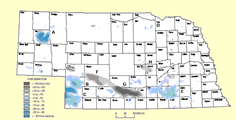Natural Resources, School of

Conservation and Survey Division: Faculty and Staff Publications
Document Type
Article
Date of this Version
2011
Citation
Turk, J.K., and R.C. Graham. 2011. Distribution an Properties of Vesicular Horizons in the Western United States. Soil Science Society of America Journal 75: 1436-1448.
Abstract
Vesicular horizons are thin (usuallycm) surface or near-surface horizons characterized by the predominance of vesicular porosity. Th ey are widespread in arid and semiarid lands, occurring on every continent and covering 156,000 km2 of the western United States. Vesicular horizons have critical implications for management due to their role in controlling surface hydrology and dust mobilization. Th is study evaluates the distribution and varia-tion in expression of vesicular horizons across the western United States using the soil databases available from the USDA. A vesicular horizon index (VHI) that incorporates vesicular horizon thickness and the size and quantity of vesicular pores was developed using soil descriptions from a published chronosequence study. Th e VHI was applied to descriptions from the soil survey databases to evaluate vesicular horizon expression across the western United States. Vesicular horizons were better expressed (higher VHI) in the Central and Northern Basin and Range com-pared to the Mojave and Sonoran Basin and Range. Th is may be due to diff erences in temperature regime or to larger areas of playas in the Central and Northern Basin and Range that serve as sources of dust that forms the par-ent material for vesicular horizons. Th e median VHI was highest in the Aridisols and Mollisols compared to other soil orders. No signifi cant relationship was found between VHI and soil textures. Vesicular horizons are widely distributed in western United States and occur across a wide range of soil types and soil-forming environments.


Comments
RS-3174